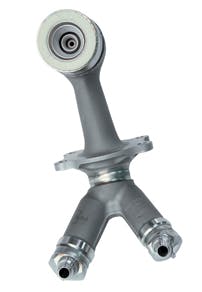Rethink Everything: 3-D Printing and the Product Design Revolution
We've been looking at 3-D printing all wrong.
By all accounts, it looks like 3-D printing is changing the manufacturing industry – every day new 3-D printed objects, devices and tools are replacing traditionally crafted parts, in some cases making manufacturing cheaper, faster and easier than ever before.
Today, GE is prepping its engines for 3-D printed fuel nozzles, athletes are running on custom printed cleats, 3-D printed jigs and fixtures are already commonplace on the machines running the shop.
But that's only half of the story, and telling focusing on those products alone misses the real point of the revolution. To Jon Cobb, executive vice president, Corporate Affairs, for 3-D printing giant, Stratasys, it might be missing the revolution itself.
"Many people look at end use parts as the nirvana of 3-D printing," Cobb explained at ASME's Advanced Design and Manufacturing Impact Forum in Buffalo last week. "But what's really interesting about 3-D printing is not how it's augmenting the way things are done traditionally. It's the way designers are utilizing 3-D printing as a new paradigm to help design a new kind of object."
It turns out that the important change 3-D printing offers the world isn't just the objects themselves. As Cobb explained, it's not simply a matter of replacing an injection molded part for an printed part; it's throwing out everything we know about part architecture and the limitations of the past and learning to design for 3-D.
The real 3-D printing revolution, he said, is what happens when designers begin mastering the new 3-D tools – all of its shortcomings, advantages and novelties – and making new things as they've never been made before.
The Future, According to Urbee
For support, Cobb points to Urbee – the futuristic-looking, 3-D printed, high performance car that made headlines last year by crossing the country on just $10 of fuel.
The car looks as slick and as space age as you'd expect from such a project – smooth edges everywhere and a sort of, lightweight bubble design for maximum performance. It is exactly the image conjured up by the combination of the words "3-d printed," "alternative fuel," and "ultra-efficient."
That certainly highlights some of large-scale design capabilities Stratasys brought to the project, but the real change, Cobb argued, is deeper in the structure.
Whereas most car bodies find strength in its steel supports, Urbee's design group took a lesson from nature to build strength from the 3-D printed material itself.
"It's built like a tree's root system," Cobb said. "Imagine an oak tree being held up by the roots, that's the kind of very organic design that you are starting to see in good 3-D printed designs."
We can see this already in some of the big mainstream 3-D printing successes.
GE's fuel nozzle, for example, isn't the same design the company has been using on jets for 30 years. It is a consolidated, streamlined design that consolidates dozens of parts and processes into one seamless piece.
It's not just another fuel nozzle. It's an engineering marvel. (See: Fear, Frenzy and the Birth of an Industry at GE's 3-D Printing Lab)
Or, back to the Urbee, Cobb explained that designers created an entirely new bumper design that fundamentally changed fender mechanics. Rather than using 300 -500 different metal fixtures and parts, he said, designers created a chaotic "bird bone" structure inside to handle the strength requirements. That meant lightweight, single process manufacturing without sacrificing any performance.
And that, Cobb insisted, is the challenge for designers and engineers of the new generation: Changes like these isn't easy, and their mechanics aren't yet totally understood.
Physics of the Revolution
"Because you are layering with 3-D printing, you're not building parts exactly the same strength as you would, say in an injection molded part," Cobb explained. "With injection molding, all of the properties of the plastic are understood, but with 3-D printing, it's not understood. It's a totally different dynamic."
Understanding the parameters of the new system, he said, means changing the design to take advantage. It means understanding the different between vertical and horizontal builds, utilizing hollow spaces and supports, looking to nature or sci-fi imaginings to create unheard of designs.
To do that, Cobb said, companies need to do a lot more than just invest in some printers and let the designers have at it. It requires a total system change.
"The real change is going to come from more of a management level at these companies," he said. "You need a cross-functional tem of people – designers, engineers, x-ray people and maybe even purchasing. You need to put together a team to look at the hypothesis that 3-D printing is in fact the correct solution."
And chances are, he said, it might not be.
"I think there is a lot of discussion in the press about wholesale change," he said. "As fantastic as that would be as a manufacturer of 3-D printing equipment, I don't think that's really going to happen any time soon."
Rather, he explained, companies seem to be taking more of a GE approach.
"GE didn't try to change the entire jet engine," he said. "They studied the problem with fuel injection and understood enough about that particular case to change the design."
That 3-D printing success, he said, is then used as a case study that the entire company will use to inform future projects across GE's design landscape. By taking the time and investing the resources to reimagine one small component of the system, the company has begun a process that will help propel new 3-D printing experiments in the future.
Over time, he said, that will begin to change the big the process of wholesale change we always seem to be waiting for. But this internal change and the design genius that it requires, he said, is the story we should be telling instead.
"This is what they call the potential of the next industrial revolution," he said. "It's not evolving by steps to something new. It's a one-step total change at the design level. From hype to hope, it's a glimpse of a tremendous future. "
About the Author
Travis M. Hessman
Editor-in-Chief
Travis Hessman is the editor-in-chief and senior content director for IndustryWeek and New Equipment Digest. He began his career as an intern at IndustryWeek in 2001 and later served as IW's technology and innovation editor. Today, he combines his experience as an educator, a writer, and a journalist to help address some of the most significant challenges in the manufacturing industry, with a particular focus on leadership, training, and the technologies of smart manufacturing.



